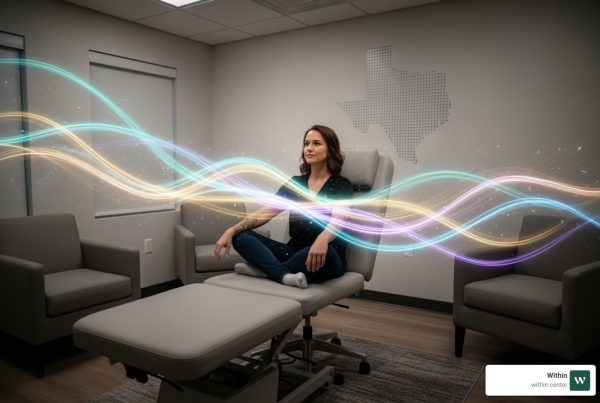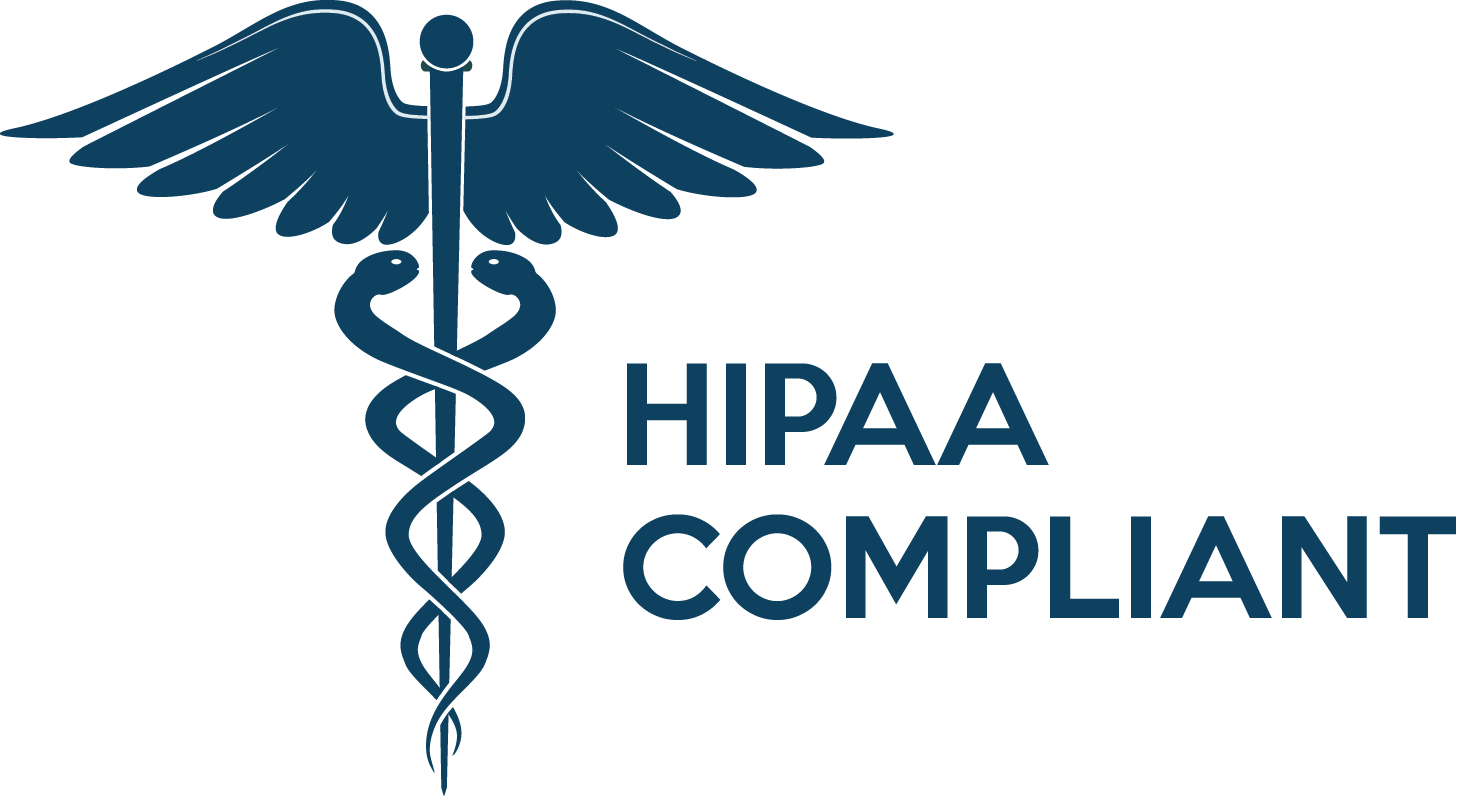Ketamine assisted psychotherapy (KAP) combines the rapid-acting effects of ketamine with traditional psychotherapy to treat mental health conditions that haven’t responded to other treatments. This emerging therapy offers new hope for people with treatment-resistant depression, PTSD, anxiety, and other challenging conditions.
What is Ketamine-Assisted Psychotherapy?
- A treatment that uses low doses of ketamine alongside therapy sessions
- Helps create new neural pathways while processing difficult emotions
- Shows rapid results, often within hours to days
- Combines medicine’s neuroplasticity effects with therapy’s healing power
Key Benefits:
- Fast-acting relief from depression and anxiety symptoms
- Improved therapy outcomes through increased brain flexibility
- Breakthrough experiences that traditional therapy alone may not achieve
- Lasting change when combined with proper integration
When traditional therapy and medications fall short, many people feel hopeless. As one researcher noted in recent studies, ketamine has become “the first psychedelic drug approved by the FDA for treatment-resistant depression” in 2019, opening doors that seemed permanently closed.
This isn’t just another treatment option. KAP works differently than standard antidepressants by targeting the brain’s glutamate system instead of serotonin. It creates a unique window of neuroplasticity – a time when your brain becomes more flexible and open to change.
The therapy happens in three main stages: careful preparation with your therapist, the actual ketamine session with professional support, and integration work to make sense of your experience and create lasting change.
The Science Behind KAP: How Ketamine Rewires the Brain
At the heart of Ketamine assisted psychotherapy lies a fascinating interaction with our brain’s chemistry. Unlike conventional antidepressants that primarily target serotonin, ketamine works on the glutamate system, a major excitatory neurotransmitter. By temporarily blocking a key receptor (NMDA), ketamine triggers a release of Brain-Derived Neurotrophic Factor (BDNF).
BDNF is often called “brain fertilizer” because it promotes neuroplasticity—the brain’s ability to form new connections and reorganize itself. This process, known as synaptogenesis, allows the brain to literally rewire itself, creating new, healthier pathways. This is believed to be the reason for ketamine’s rapid-acting antidepressant effects, with many patients reporting improvements within hours to days, a stark contrast to traditional medications.
Scientific research on ketamine’s mechanisms
The Role of the Dissociative Experience
Beyond its neurobiological effects, ketamine’s ability to induce a dissociative state is a key component of its therapeutic power. This temporary shift in perception, often described as a feeling of detachment from one’s body or usual thoughts, can lower psychological defenses. This allows for the safe exploration of painful emotions or memories that might be too overwhelming in traditional talk therapy. Patients often report gaining new, objective perspectives on their struggles, leading to profound insights and emotional release.
Systematic review of KAP’s active mechanisms
From Anesthetic to Antidepressant: A Brief History
Ketamine was first synthesized in 1962 and approved as an anesthetic in 1970. Its safety and effectiveness made it a staple in operating rooms and on battlefields. Researchers in the 1970s noted its potential for psychotherapy, but this exploration was largely paused during the “War on Drugs.” Renewed scientific interest has since propelled ketamine back into the spotlight, culminating in the 2019 FDA approval of a ketamine-derived nasal spray (esketamine) for treatment-resistant depression, marking a new era for psychedelic-assisted therapies.
The Complete Guide to Ketamine-Assisted Psychotherapy (KAP)
Ketamine assisted psychotherapy is a structured process designed to maximize therapeutic benefits while ensuring patient safety. It’s a holistic experience that combines medicine with expert therapeutic guidance. This section explains the typical protocol and what a patient can expect.
The Three Pillars: Preparation, Session, and Integration
Our approach to Ketamine assisted psychotherapy is built upon three crucial pillars: preparation, the dosing session, and integration. Each stage is vital for a safe, meaningful, and lasting therapeutic outcome.
- Preparation Sessions: Before your first ketamine dosing session, you’ll engage in preparatory psychotherapy sessions. This is where we establish a strong therapeutic alliance, discuss your intentions for the treatment, and set a positive framework for the journey ahead.
- Dosing Session: The ketamine dosing session is conducted in a quiet, relaxed, and safe environment, often with comfortable seating and curated music. You will be continuously monitored by our trained team, ensuring your physical safety and providing compassionate support throughout the experience, which typically lasts about 40-60 minutes.
- Integration Sessions: This is arguably the most critical pillar for long-term change. Following each dosing session, we engage in integration psychotherapy. This is where we work together to process and make sense of your ketamine experience. The neuroplastic window created by ketamine makes your brain particularly receptive to new learning and behavioral changes during this time, helping you weave new insights into your daily life.
The Clinical Team: Roles of the Physician and Therapist
Ketamine assisted psychotherapy is a collaborative effort between medical and psychological professionals. A physician handles the medical screening, determines the appropriate dosage, and monitors your physical safety during the session. The therapist conducts the psychological assessment, helps you set intentions, and provides support during the session. Most importantly, they lead the integration sessions, helping you process the experience and apply insights to your life. This collaborative model ensures both your physical and psychological well-being are prioritized.
Dosing and Administration Approaches
The way ketamine is administered in Ketamine assisted psychotherapy can vary, and the choice depends on several factors, including the therapeutic goals and clinical setting. The aim is to use a sub-anesthetic dose—a dose low enough to induce therapeutic effects without causing full unconsciousness.
| Route of Administration | Description | Onset of Effects | Duration of Effects (Acute) |
| Intravenous (IV) | Administered directly into the bloodstream via a drip. Allows for precise control over the dosage and a rapid onset of effects. This is a common method in clinical settings. | 1-2 minutes | 45-60 minutes |
| Intramuscular (IM) | Injected into a large muscle, like the thigh or arm. The onset is slightly slower than IV but still provides a powerful and immersive experience. | 3-5 minutes | 60-90 minutes |
| Sublingual/Oral | A lozenge or liquid is held in the mouth for a period of time before swallowing. This method has a slower, more gentle onset and is often used for at-home integration support or in specific therapeutic protocols. | 15-30 minutes | 90-120 minutes |
Applications, Benefits, and Risks of KAP
Ketamine assisted psychotherapy has shown promise for a range of conditions, particularly treatment-resistant depression (TRD), post-traumatic stress disorder (PTSD), and various anxiety disorders. Studies indicate that when combined with psychotherapy, ketamine can lead to rapid and significant reductions in symptoms, often within hours or days. This provides a crucial window for therapeutic work.
Potential Benefits of Ketamine-Assisted Psychotherapy
The appeal of Ketamine assisted psychotherapy lies in its unique and often profound benefits:
- Rapid Symptom Relief: Offers fast-acting relief from severe symptoms of depression and anxiety.
- Decreased Suicidal Ideation: Research shows a significant reduction in suicidal thoughts, often within hours of treatment.
- Therapeutic Breakthroughs: The ketamine experience can lower psychological defenses, allowing for deeper processing of trauma and ingrained negative patterns.
- Improved Neuroplasticity: By promoting the brain’s ability to form new connections, KAP helps individuals develop healthier ways of thinking and coping.
- Sustained Improvement: When combined with integration therapy, the insights and changes from KAP can lead to long-term, sustainable well-being.
Understanding the Risks and Side Effects
While KAP is generally safe when administered in a clinical setting, it’s important to be aware of potential side effects. Most are temporary and resolve shortly after the session.
Common side effects include:
- Dissociation: A temporary feeling of being disconnected from your body or reality.
- Nausea and Dizziness: These can occur during or shortly after the session.
- Increased Blood Pressure: Vital signs are monitored throughout the session to manage this effect.
It is crucial to seek treatment from a licensed medical professional. The FDA has issued warnings about the risks associated with compounded ketamine products when not used under proper medical supervision. A thorough medical and psychological screening is necessary to ensure KAP is a safe and appropriate treatment for you.
FDA warning on compounded ketamine products
The Broader Context: KAP, Regulations, and the Future
This section places Ketamine assisted psychotherapy within the wider landscape of mental health, exploring its unique approach, regulatory status, and the future of psychedelic medicine.
How KAP Differs from Other Treatments
Ketamine assisted psychotherapy is distinct from both traditional talk therapy and simple ketamine infusions. While talk therapy is effective for many, it can sometimes stall when individuals struggle to access deeply rooted emotional patterns. KAP uses ketamine to create a state of heightened neuroplasticity and reduced psychological defenses, allowing for more profound therapeutic breakthroughs.
Unlike clinics that offer ketamine infusions without therapy, KAP emphasizes integration. The ketamine experience opens a window for change, but it is the therapeutic work done before, during, and after that helps translate those insights into lasting healing. This synergy between medicine and therapy is what makes KAP a uniquely powerful treatment model.
The Regulatory Landscape in Canada and the U.S.
In the United States, ketamine is FDA-approved as an anesthetic. Its use for mental health conditions is considered “off-label,” a common and legal practice where a physician prescribes a drug for a condition other than what it was officially approved for, based on strong scientific evidence. The nasal spray esketamine (Spravato) is specifically FDA-approved for treatment-resistant depression. In Canada, the situation is similar, with physicians able to prescribe ketamine off-label for psychiatric conditions.
Given this landscape, it is vital to choose a reputable clinic that provides comprehensive medical screening and supervision. Organizations like the Ketamine Assisted Therapy Association of Canada (KATA) are working to establish best practices and ensure high standards of care.
The Future of Psychedelic-Assisted Therapy
We are in a “psychedelic renaissance,” with Ketamine assisted psychotherapy leading the way. Ongoing research is exploring other compounds like psilocybin (from mushrooms) for depression and MDMA for PTSD, both of which show incredible promise in clinical trials.
These therapies are shifting the focus from mere symptom management to holistic healing. By creating opportunities for profound personal insight and brain-level change, they represent a new frontier in mental healthcare. As research continues and regulations evolve, these treatments are becoming more accessible, offering hope to millions.
The past and future of psychedelic science
Conclusion: Your Path to Healing and Integration
Ketamine assisted psychotherapy represents a groundbreaking shift in how we approach mental health. By combining ketamine’s ability to create new neural pathways with the transformative power of therapy, KAP opens doors that traditional treatments sometimes can’t.
We’ve explored the science, the process, and the profound benefits of this innovative treatment. The key to its success lies in the synergy between the medication and the integration work that follows, turning temporary insights into lasting change.
For those ready to begin this journey, finding the right setting is essential. At Within, our immersive retreat experience at AWKN Ranch provides a safe, supportive environment dedicated to your healing. Our holistic approach ensures you have the time, space, and professional guidance to process your experience and integrate it into your life.
The future of mental healthcare is expanding, and ketamine assisted psychotherapy is at the forefront. It offers a powerful new tool for those seeking a breakthrough from treatment-resistant conditions.
Explore our ketamine-assisted therapy program




